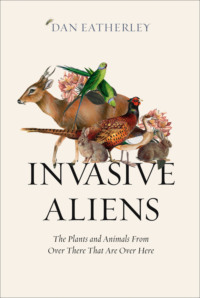
Полная версия
Invasive Aliens: Rabbits, rhododendrons, and the other animals and plants taking over the British Countryside
If the invaders left people alone and restricted their impacts to the degrading of natural ecosystems, that would be bad enough – not least as we ultimately depend upon these systems for our survival and wellbeing. But some non-natives harm us directly. Notwithstanding the odd pinch on the privates from a crayfish, the obvious threat is their role as agents of disease. The most notorious example in history is offered by the Black Death, inflicted by a strain of bacteria originating in Asia which, from the fourteenth century onwards, has killed tens of millions across Europe, the Middle East and North Africa. While nothing on that scale has recently been visited upon us here in Britain, new parasites and pathogens are on the radar, many transmitted by mosquitoes and other biting insects. At the moment, it’s a bit chilly for these to get a foothold here, but with climate change all bets are off.
Judging by the growing scientific literature devoted to the economic impacts of biological invaders, these species hurt our pockets too. Much of the cost arises from direct impacts such as insect pests reducing yields from agriculture and forestry, fish stocks wiped out by disease or the erosion caused when signal crayfish or Chinese mitten crabs tunnel into river banks. To the ledger we must add the eye-watering sums spent on preventing, monitoring and eradicating invasives. In excess of £5 million is spent every year in Britain removing Japanese knotweed alone. Various indirect impacts, trickier to calculate but just as real, and many times greater than the direct costs, can also be attributed to invasives. This is a complex area, but it boils down to the loss of valuable ecosystem services like nutrient cycling, pollination or flood prevention.
Overall costs incurred by invasive non-native organisms are estimated to amount to 5 per cent of the global economy. Across Europe, invasives inflict some £9-billion worth of damage every year. In the UK alone, the figure has been put at about £1.7 billion annually. Although these are ballpark estimates, resting on plenty of assumptions and subject to much debate, governments the world over are taking notice as never before. Invasive species are fast becoming public enemy number one. In 2016, the European Union banned 37 of the most problematic plants and animals from being kept or traded without a permit. These include signal crayfish, raccoons and American skunk cabbage. On this side of the Channel, the Great Britain Non-Native Species Secretariat was set up a decade ago and tasked with detecting and containing invaders, as well as helping to predict and prevent future incursions. Tackling troublesome non-natives is complex: the measures taken can be extraordinary and sometimes cause more problems than they solve, even hurting the very ecosystems they’re intended to protect.
An emerging school of thought is suggesting that the threat of invasive species has been exaggerated, that we should stop worrying about non-natives and even welcome them for the benefits they can bring. At the other extreme, a growing band of conservationists is going beyond simple calls for the eradication of non-natives to campaign for the deliberate reintroduction of a menagerie of native British plants and animals which have become extinct at the hands of humans. To its critics, the ‘re-wilding’ movement is pure eco-nostalgia.
For me though, most fascinating of all is that non-native organisms, invasive or otherwise, from rabbits to rhododendrons, mink to muntjac, hold up a mirror to our own species. Yes, the pace of invasion is higher than ever before but problematic non-natives aren’t a modern phenomenon: they’ve been with us from the outset, as unavoidable a corollary of the human way of life as cleared forests and piles of garbage. From the earliest settlement of our islands and first experiments with farming, through the Roman and medieval times, and the age of exploration by Europeans, to the current period of globalised free-for-all, the story of invasive species is the story of our own past, present and future.
Конец ознакомительного фрагмента.
Текст предоставлен ООО «ЛитРес».
Прочитайте эту книгу целиком, купив полную легальную версию на ЛитРес.
Безопасно оплатить книгу можно банковской картой Visa, MasterCard, Maestro, со счета мобильного телефона, с платежного терминала, в салоне МТС или Связной, через PayPal, WebMoney, Яндекс.Деньги, QIWI Кошелек, бонусными картами или другим удобным Вам способом.


